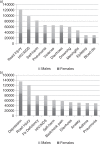Building our youth for the future
- PMID: 25724512
- PMCID: PMC4344540
- DOI: 10.7448/IAS.18.2.20027
Building our youth for the future
Abstract
Adolescents and young adults are at increased risk for HIV due to the many developmental, psychological, social, and structural transitions that converge in this period of the lifespan. In addition, adolescent deaths resulting from HIV continue to rise despite declines in other age groups. There are also young key populations (YKPs) that bear disproportionate burdens of HIV and are the most vulnerable, including young men who have sex with men (MSM), transgender youth, young people who inject drugs, and adolescent and young adult sex workers. As a society, we must do more to stop new HIV infections and untimely HIV-related deaths through both primary and secondary prevention and better management approaches. Using an interwoven prevention and treatment cascade approach, the starting point for all interventions must be HIV counselling and testing. Subsequent interventions for both HIV-negative and HIV-positive youth must be "adolescent-centred," occur within the socio-ecological context of young people and take advantage of the innovations and technologies that youth have easily incorporated into their daily lives. In order to achieve the global goals of zero infections, zero discrimination and zero deaths, a sustained focus on HIV research, policy and advocacy for YKPs must occur.
Keywords: HIV; Prevention and treatment; young key populations.
Figures



References
-
- Center for Strategic & International Studies. The global youth wellbeing index [Internet] 2014. [cited 2015 Jan 3]. Available from: http://www.youthindex.org/contact/
-
- World Health Organization (WHO) Health for the world's adolescents: a second chance in the second decade. Geneva: World Health Organization; 2014.
-
- Fact sheet on adolescent health. Geneva: WHO [Internet]; 2014. [cited 2014 Jul 2]. Available from: http://www.unaids.org/en/media/unaids/contentassets/documents/factsheet/....
-
- Joint United Nations Programme on HIV/AIDS (UNAIDS) The gap report – July 2014. Geneva: UNAIDS; 2014.
-
- United Nations Children's Fund. Towards an AIDS-free generation – children and aids: sixth stocktaking report, 2013. New York: UNICEF; 2013.
Publication types
MeSH terms
Grants and funding
LinkOut - more resources
Full Text Sources
Medical
Molecular Biology Databases
Research Materials

